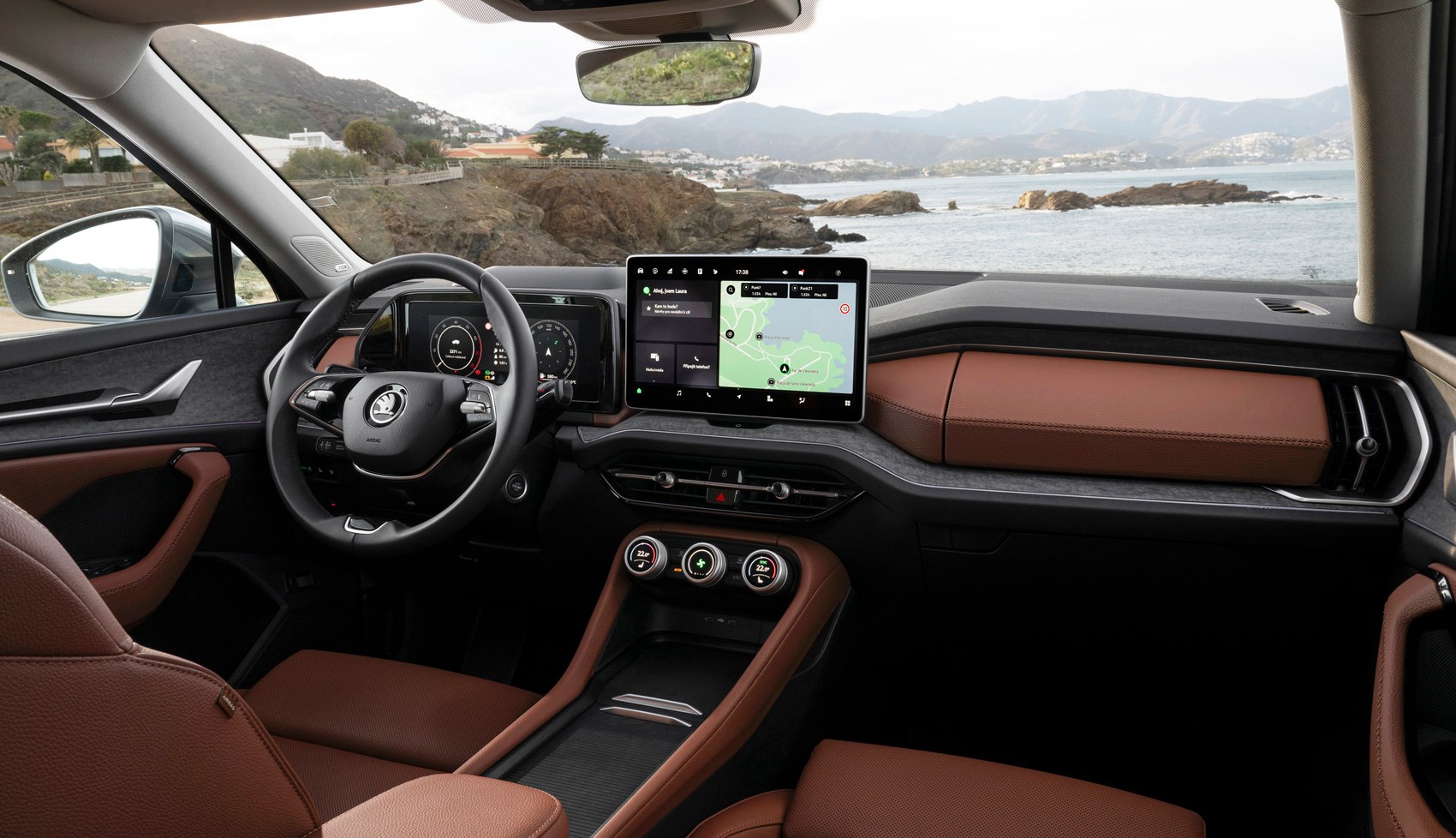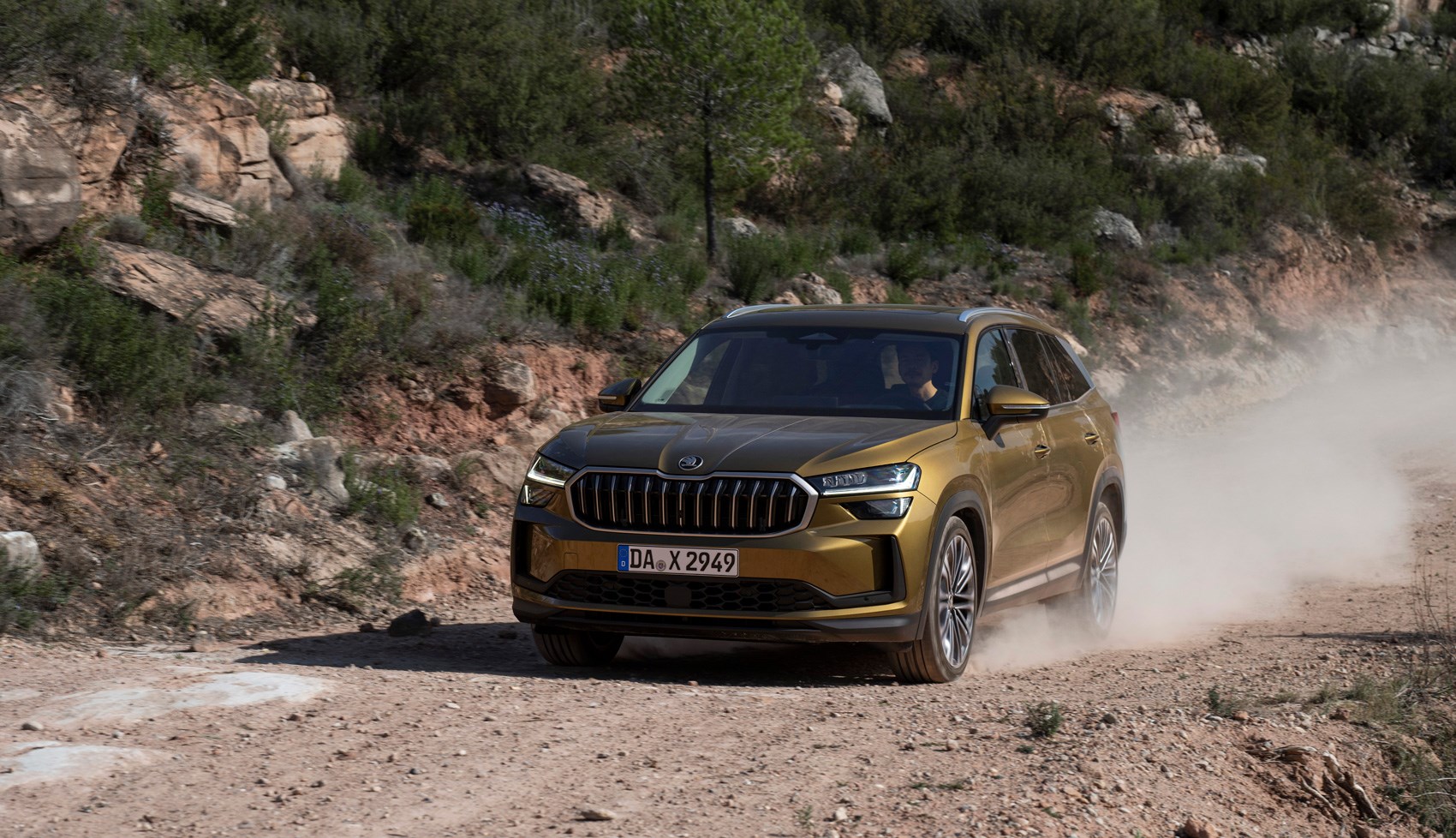The new Skoda Kodiaq Mk2 looks a lot like the Mk1, because it is. Any why wouldn’t Skoda stick closely to a winning formula? Since 2016, when it was launched, Skoda has shifted more than 860,000 Kodiaqs. Britain is the second-largest market, behind Germany and ahead of the car’s native Czech Republic.
It’s done so well because it’s always been a keenly priced large family car, offered with five or seven seats. It shares many of its qualities with the Superb estate: easy to get on with, brilliant room in the back, decent to drive.
It relies heavily on technology from parent company VW, but has generally been perceived as being a better package than in-house rivals such as the Seat Tarraco and the now departed VW Tiguan Allspace.
At a glance
Pros: Massively flexible, lots of spec choice, sensible interior, smooth to drive
Cons: Not as good value as it used to be, not particularly exciting
What’s new?
The new Kodiaq is longer and roomier, for passengers and luggage alike. It has some significantly new elements in the cabin, with a greater emphasis on sustainability.
There are new lights, a new logo, a new grille with new air intakes underneath, a new spoiler sticking out the back of the lengthened roof, and some new colours. Put them side by side and you won’t have to think twice about which is the old one and which is its replacement. There are new alloy wheels, from 18 to 20 inches.

But visually it’s more of the same: not exactly handsome, and not a world apart from various Seat, VW and Audi products, but it succeeds in looking smart, modern, functional and stylish enough.
What are the specs?
Initially there are two spec levels, SE and SE L. Sportline will be along soon, with marginally more visual pizzazz. And later there will be a vRS version.
SE comes with 18-inch wheels, front and rear LED lights, heated front seats and three-zone climate control, plus a bunch of safety-enhancing electronics. SE L – priced from £40,205 – has 19-inch wheels as standard, adaptive matrix LED headlights, an electronically adjustable driver’s seat and electric boot opening. There are also various interior design packages available, called ‘selections’, following the pattern established by the Enyaq.
There are several engines to pick from: a 148bhp mild-hybrid 1.5-litre petrol four-cylinder, a 201bhp 2.0-litre TSI (which is all-wheel-drive only), a 148bhp 2.0-litre diesel four and a 190bhp version (the latter being only for all-wheel drive). Some models are available with DCC adaptive suspension, which when set in Sport mode adds a welcome firmness.
The PHEV is front-wheel drive and five seats only. It has a six-speed DSG automatic transmission, where the others all have seven speeds. But there’s no electric option. If you want a Skoda SUV with EV propulsion, you need to be looking at the Enyaq.
What about the interior?
The best thing about the Kodiaq. There’s nothing radically different or innovative, but it’s a very successful mix of familiar and new, of traditional and advanced.
It’s still very roomy – in fact slightly roomier than before, with an expanded boot and more headroom for those in the third row, while having a sleeker shape that has reduced aerodynamic drag.
If you go for seven seats you get less boot space than five-seaters, and if you go for the plug-in hybrid version you get less luggage capacity than those opting for versions that don’t have a big battery under the floor. But even the least capacious boot is still usefully roomy, and the largest is cavernous: 910 litres with the second row in use, and 2105 litres with them folded down, which is done with a simple flick of a lever.
The passenger seats split 60:40, and can be slid forwards or back to give more boot space or more legroom. Even with the front seats back and the back seats forwards, adults will be comfortable.
Rear passengers get heating controls and chargers plus a centre console of sorts, with oddments space and two cupholders. This can be removed if an adult is going to sit in the middle seat.
Up front the centre console is a masterclass in practicality. As the new Kodiaq is not available with a manual gearchange, the selector has been moved to the steering column, freeing up lots of space, which Skoda’s interior designers have used well. There are up to four cupholders, depending how you choose to arrange it, plus wireless charging areas for two phones, a couple of C-USB ports, and a lot of space in the armrest.
The dashboard now hosts a 13-inch central touchscreen, which is logically laid out and configurable. It can be largely ignored on the move, thanks to three physical multi-purpose dials below the screen, which between them control functions including driving modes (on those models that have modes), volume and heating. It’s an intuitive, effective arrangement.
The steering wheel isn’t overburdened with controls, but those that are present are easy to operate without taking your eyes off the road. The wheel itself may look as though it’s flat-bottomed, but that’s an illusion – it’s actually round, with a decorative protrusion around the 6 o’clock mark.

The doors have those useful removable rubbish bins for sweet wrappers and the like in their pockets, and slotted into the driver’s door itself is an umbrella – a familiar Skoda touch, along with the ice scraper clipped into the fuel filler cap. A new detail, along similarly user-friendly lines, is the cap on the screenwash reservoir under the bonnet. It opens up into a funnel that will reduce the amount of wasteful splashing.
Interior fabric choices include a really nice material that is made of recycled plastic, and leather that is treated with coffee-bean waste, rather than chemicals, in the tanning process.
A head-up display is now available, and there’s the option of a big glass sunroof to bring a bright ambience to the cavernous cabin. Despite its size, it doesn’t sound boomy or creaky, thanks to a combination of effective sound-deadening and sturdy construction.
How does it drive?
We’ve sampled four versions so far: two diesels, the mild hybrid and the plug-in hybrid. They weren’t in complete alignment with UK spec, but close enough for us to be pretty confident about their respective strengths and weaknesses.
The mild hybrid, which we drove on a demanding route involving many hairpin bends and some fast motorway miles, returned an impressive real-world 35mpg. But as you might expect from a 148bhp motor in such a big car, it doesn’t offer scorching performance. On those hills, it wasn’t exactly struggling but it certainly wasn’t shining. In more typical family driving, it’s smooth, lively enough and easygoing.
The plug-in hybrid is much perkier, reflected in a 0-62mph time that, at 8.4 seconds, is 1.3 seconds quicker. And if it replicates the official figures, it will top 60 miles of electric-only running, using its 25.7kWh battery, and recharge quickly. But a much longer drive will be needed to check that out.
Quite possibly the sweet spot in the range is the lesser of the two diesels. In five-seat SE guise, it costs £38,945 and combines a 9.6sec 0-62mph time with economy around 50mpg. Its torquey nature makes it feel faster than that, and it’s untroubled by hills or heavy loads. The more powerful diesel is faster off the line, with a 7.8sec sprint time, but it’s thirstier, has a higher CO2 output, and currently only comes as a seven-seat 4×4 in SE L trim, which pushes the price to £56,225.
All this talk of performance is pretty much beside the point. The Kodiaq is not designed to by dynamically outstanding, and is at its best when it’s used for its core tasks of family holidays, the school run, shopping and taking vast quantities of garden waste to the tip.
Ride quality is good, but the body gets wobbly if you hammer it hard through the bends. And the steering is always a little vague and remote. That may change when the vRS version arrives, but for now the Kodiaq is going to bring at least as much pleasure to the passengers as to the driver.
Verdict: Skoda Kodiaq
The Kodiaq shows Skoda doing typical Skoda stuff very well. The details are fantastic, the refinement is good, it drives well but not brilliantly, and it gives off a general feelgood vibe rather than any eruptions of excitement.
There are plenty of choices for buyers wanting family-friendly SUVs, and this remains among the best, certainly when you factor in the cost. Its pricing undercuts the seven-seat Hyundai Santa Fe. The Mercedes GLB, Peugeot 5008 and Land Rover Discovery Sport are classy seven-seat alternatives, but not as roomy.
And if you don’t want seven seats, you have a huge variety of alternatives. Don’t overlook Skoda’s own similarly priced Superb estate, which has the same clever design, technology and detailing as the Kodiaq, but a little more to engage the driver too.
That said, the Kodiaq is a very pleasing all-round package, with the prospect of better versions still to come.
Specs
Price when new: £36,645
On sale: Now
Engine: 1498cc mild-hybrid turbocharged four-cylinder, 148bhp @ 5000rpm, 184lb ft @ 1500rpm
Transmission: Seven-speed dual-clutch automatic, front-wheel drive
Performance: 9.7sec 0-62mph, 129mph, 42.8-47.8mpg, 135-151g/km CO2
Weight / material: 1586kg/steel
Dimensions (length/width/height in mm): 4758/1864/1659
Source: carmagazine.co.uk











